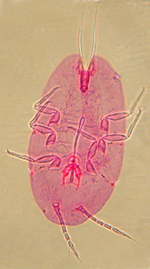Biology
Watch a short video of newly emerged Paralecanium expansum metallicum crawlers, filmed down a microscope. They have hatched from eggs underneath the adult female, whose lower surface is visible.
Most soft scales, and members of several other scale insect families, have a strange life cycle that involves spending almost their entire lives in a sessile (immobile) state.
Paralecanium expansum metallicum life cycle

Phase-contrast photomicrograph of a P. expansum metallicum crawler. The specimen has been stained pink to make it easier to locate on the slide.
First-stage nymphs, termed crawlers:
- hatch from eggs that are protected underneath the adult female’s body
- can walk short distances
- act as the main means of dispersal from one plant to another, or from one area to another
P. expansum metallicum crawlers provide a very effective means of dispersal as they are:
- only 0.5mm long
- extremely light
- readily carried by air currents
Once the crawler has selected a feeding site it undergoes its first moult.
From the second stage onwards
P. expansum metallicum females:
- do not have functioning legs. Adult females don't even have the vestiges of legs
- simply feed on the host plant’s phloem sap: if the plant dies, so do they
Some other soft scales do have short-but-functional legs but mobility is still extremely limited.
In complete contrast to females, male scale insects have:
- long legs
- a single pair of wings in most cases
- no functioning mouthparts
So they have very limited time in which to seek out females in order to mate.